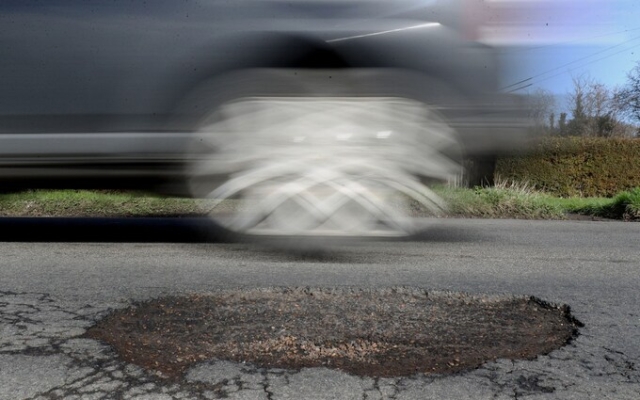 Last year, 8,000 miles of roads were classified as “structurally good” compared to the previous year. Photo: Gareth Fuller/PA
Last year, 8,000 miles of roads were classified as “structurally good” compared to the previous year. Photo: Gareth Fuller/PA
When Prime Minister Rishi Sunak abandoned stage two of HS2, he promised that billions of pounds of savings would be redirected towards new infrastructure projects.
In his speech at the Conservative Party conference, he pledged to «reinvest every penny of £36 billion in hundreds of new transport projects in the North and Midlands across the country.»
This may sound like a revolution, but it's anything but. Much of this money is simply used to repair existing infrastructure — namely Britain's crumbling roads.
As MPs call for tax cuts in this week's autumn statement and Chancellor Jeremy Hunt tries to find ways to boost economic growth, the country's finances have become hostage to potholes.
Last week the government announced that almost a quarter of HS2 savings — a total of £8.3bn — would be redirected towards resurfacing local roads. This is the largest increase in money ever allocated to fix potholes in local areas.
There's a good reason for that: the situation is urgent. The UK's local roads are in the worst condition for 28 years, according to the annual local authority road maintenance survey, aptly named ALARM.
«Our roads are deteriorating right in front of us,» says Rick Green, chairman of the Asphalt Industry Alliance (AIA), which is conducting the study.
Potholes can be deadly, especially for cyclists and motorcyclists. They also cause huge problems for motorists. This year could be one of the worst on record for pothole-related breakdowns, warns Jack Cousins, head of roads at the AA.
In the first nine months of 2023, potholes accounted for nearly all crashes. The 460,000 claims to the AA are almost a fifth higher than in the same period last year and 8% higher than in pre-pandemic 2019.
Separate figures from the RAC, which has its own pothole index, show that the number of pothole-related breakdowns between July and September was the highest on record for this time of year since at least 2006.
The results are extremely destructive and expensive. Each pothole-related breakdown costs drivers £440, according to the RAC. Poor roads interfere with delivery, waste collection and recycling. Special repairs cost municipalities 50% more than planned repairs.
While the number of accidents is rising, repair work is going in the opposite direction. According to the AIA, the number of potholes repaired over the past year has dropped from 1.7 million to 1.4 million
As a result, 8,000 miles of road were classified as structurally “good” in less than a year. sooner.
The road should be repaved every 20 to 30 years, Cousins says. Today in Britain it takes an average of 116 years to repair local roads, says the AIA.
“If this happens on your street, you will never see it happen again in your life,” says the AIA. Cousins.
The UK has a different system for maintaining 'strategic' roads, namely motorways and dual carriageways. The speed of traffic on these roads means that, generally speaking, highways are inspected once a month and residential streets are inspected once a year, Cousins says. Repairing «strategic» roads does not rely on local authority funds.
However, although these main roads carry the bulk of British traffic, they form only part of the national road network, says Green.< /p>
“When you think about it, every journey that anyone ever takes starts and ends on a local road. Every time someone goes to work, school or the hospital.»
Local road conditions take away both political capital and real resources.
«Potholes and road conditions are an absolute totem of the feeling of a nation that cannot quite get its act together,” says Ben Shimshon, executive director of Thinks Insights and Strategy. “When you ask people what they need to see to feel like things are getting better, they often talk about the condition of the roads.”
 The condition of roads is often used as an indicator of the state of a country. Photo: Robin Boultwood/BNPS.co.uk
The condition of roads is often used as an indicator of the state of a country. Photo: Robin Boultwood/BNPS.co.uk
The government knows this. Successive Conservative chancellors have struggled to allocate money to plug potholes. It all started in 2015 with the creation of the Pothole Fund, which was allocated £296 million over six years.
The figures quickly became staggering: in 2020, then-chancellor Rishi Sunak committed £2.5 billion over five years, or £500 million a year. In March this year, Hunt added a one-off payment of £200 million to that sum. Now the allocated savings from HS2 mean local authorities will receive around £800 million a year for 11 years.
The problem started with funding cuts. Britain's pothole plague is the result of years of underinvestment, says James Heath, chief executive of the National Infrastructure Commission.
«This money is about catching up,» he says. “Clearly this is a long-standing problem that needs to be addressed.”
According to the Institute of Government, massive spending cuts since the financial crisis have seen central government grants to local authorities fall from £46.5bn in 2009/10 to £28.0bn by 2019/20 today. prices.
Local authorities partly offset this 40% fall by raising council tax, but the scale of the fall means purchasing power still fell by 17.5% over the period.
Faced with a choice, many councils have prioritized spending on schools and children's social care over road maintenance.
«Roads don't collapse suddenly, they just gradually get worse and worse, so it's easier to kick the can further down the road when times get tough,» says AIA's Green.
But there's always a tipping point, and ours roads are becoming increasingly fragile.
“Many of our highways and roads were built in the 50s, 60s and 70s. These are aging assets,” says Heath.
He adds that increasingly extreme and changeable weather conditions mean that the pressure on roads is also increasing.
Potholes are caused by defects in the asphalt surface. Traffic increases this imperfection, causing cracks to appear. When water gets into cracks and freezes, it expands. A crack becomes a pothole.
More cold spells mean more freezes and more potholes.
Cousens says, “Certainly climate change does play a role in the long-term condition of our roads. and how potholes form throughout the year.”
Heat waves also play a role.
“At a certain point, the asphalt starts to melt,” Cousins says. “This in itself creates defects which then become potholes.”
Road repairs have become a source of cash that even £8.3 billion cannot fully fill. According to the AIA, local authorities in England and Wales face a £1.3 billion road maintenance shortfall each year.
Despite Sunak's efforts to fix our roads, the hole is only getting deeper.
Despite Sunak's efforts to fix our roads, the hole is only getting deeper.
Despite Sunak's efforts to fix our roads, the hole is only getting deeper.
p> p>




















































Свежие комментарии